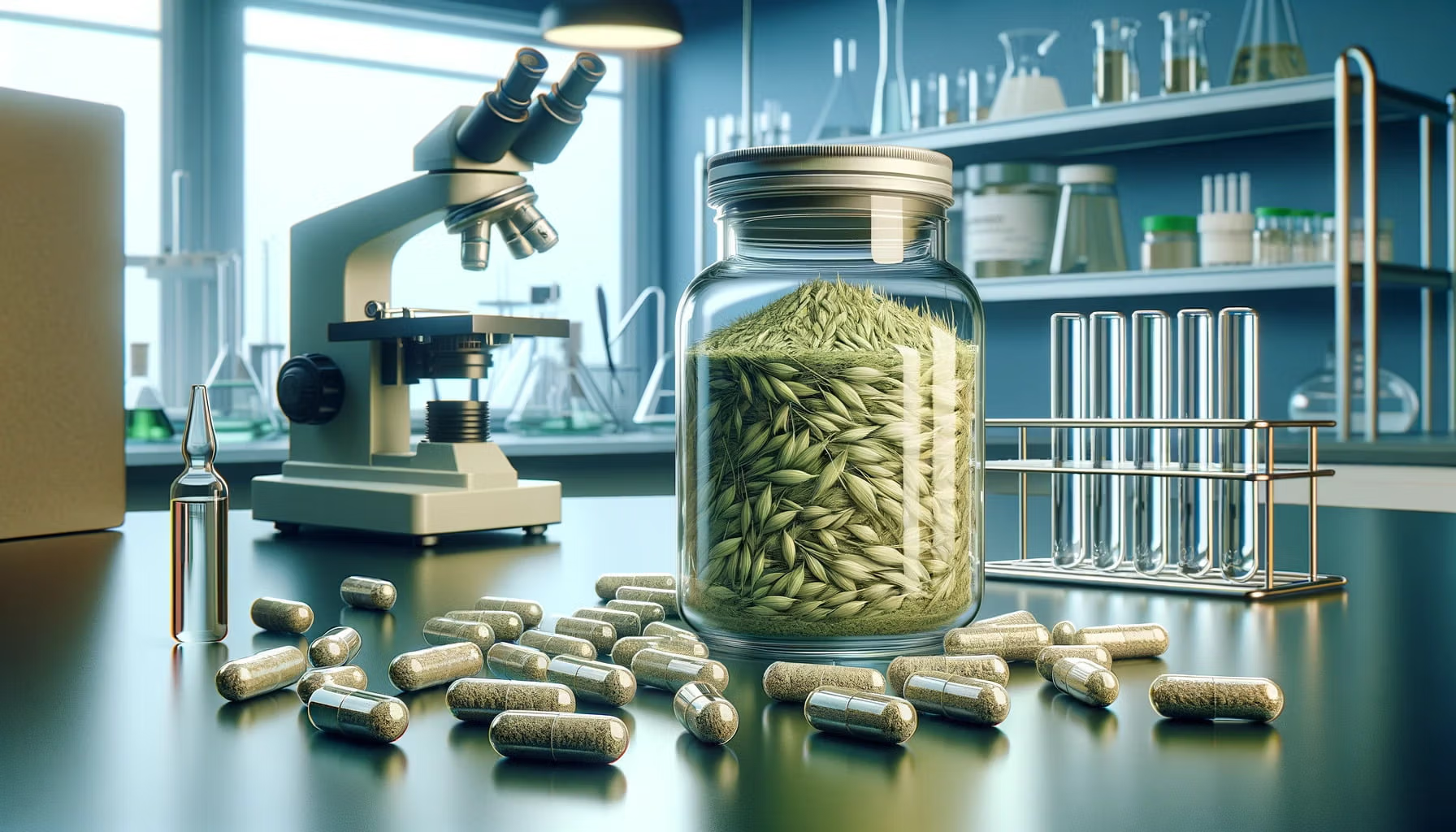
Oat straw, also known as Avena sativa, has a remarkable ability to enhance cognition by increasing alpha brain waves. These brain waves are responsible for our ability to learn and absorb new ideas, as well as experience joy.
Read on to learn more about the science behind oat straw’s nootropic properties, and how to incorporate it into your brain health regimen.
Table of Contents
What Is Oat Straw?

Oat Straw, also known as Oat Hay or Avena Sativa, is the dry, fibrous stalk material left after harvesting oat grain. It’s a byproduct of cereal crop cultivation rich in fiber. This agricultural byproduct is coarse, lightweight, and dry, with a typical moisture content of 8-12%. While low in protein (3-5%) and high in indigestible crude fiber (35-45%).
Oat Straw is a natural nootropic that can enhance cognitive performance, mental well-being, and brain health when used responsibly.
The beneficial properties of Oat Straw are attributed to unique compounds like avenanthramides, flavonoids, saponins, and alkaloids concentrated in the green, immature oat plant.
What Are the Different Names for Oat Straw?
Oat straw is known by several synonyms, including:
- Oat hay
- Oat hulls
- Oat chaff
These terms generally refer to the same plant material, although some may emphasize specific parts of the oat plant.
How Does Oat Straw Differ from Oat Grain?
Oat straw and oat grain are distinct parts of the oat plant with different compositions and uses:
- Oat grain, also called oat seed or oat kernel, is the edible, nutrient-rich seed harvested for human consumption and animal feed.
- Oat straw, in contrast, is the fibrous, inedible byproduct consisting of the plant’s stems, leaves, and sheaths.
While oat grain is valued for its nutritional content, oat straw has gained attention for its potential brain health benefits when consumed as a supplement or tea.
What Are the Main Structural Components of Oat Straw?
Oat straw primarily consists of three main structural components:
- Cellulose: Provides tensile strength and stability to the stems and leaves, enabling the plant to grow upright and withstand environmental stresses.
- Hemicellulose: Contributes to the structural integrity of the stems and leaves, providing flexibility and support to the plant tissue.
- Lignin: Acts as a binder, providing rigidity and resistance to degradation. It also plays a role in water transport and defense against pathogens.
What Are the Bioactive Compounds Present in Oat Straw?
In addition to its structural components, oat straw contains several bioactive compounds that may contribute to its potential health benefits:
- Flavonoids: Antioxidant compounds that may support brain function and cardiovascular health.
- Saponins: Plant compounds with potential neuroprotective and cognitive-enhancing effects.
- Alkaloids: Nitrogen-containing compounds that may have calming and mood-supportive properties.
The presence of these bioactive compounds has sparked interest in oat straw as a potential nootropic and wellness supplement.

What Are the Potential Cognitive Benefits of Oat Straw?
While more human clinical trials are needed, the available evidence indicates Oat Straw can optimize brain function and performance when used appropriately. Its antioxidant, anti-inflammatory, and neuroprotective properties make it a promising natural brain booster.
Can Oat Straw Improve Memory and Cognitive Function?
Studies suggest that oat straw may have a positive effect on memory and cognitive performance. For example, a randomized, placebo-controlled trial conducted by Berry et al. (2011) found that consuming 1500 mg of oat straw extract daily for 12 weeks significantly improved attention and concentration in healthy adults aged 40-65 years.(1)
Can Oat Straw Enhance Focus and Concentration?
Oat straw has been traditionally used to support focus and concentration. A study by Martinez-Horta, Saul et al. (2021) investigated the acute cognitive effects of oat straw extract in healthy adults. The researchers found that a single dose of 800 mg oat straw extract significantly improved attention and concentration compared to placebo.(2)
Can Oat Straw Reduce Stress and Anxiety?
Some evidence suggests that oat straw may have calming and anxiety-reducing properties. David Kennedy et al. (2020) conducted a double-blind, placebo-controlled study on the effects of oat extract on stress responses and mood for healthy participants aged 35 – 65 years. The researchers found a single dose of 1290 mg of oat straw for 4 weeks significantly improved cognitive performance on a computerized version of the Corsi Blocks working memory task and a multitasking task.(3)
While some of these findings are promising, more human studies are needed to confirm oat straw’s potential stress-reducing benefits.
What Are the Mechanisms of Action Behind Oat Straw’s Cognitive Benefits?
The cognitive benefits of oat straw are thought to be mediated by several bioactive compounds and their interactions with the brain and nervous system:
How Do the Flavonoids in Oat Straw Affect Brain Function?
Flavonoids are antioxidant compounds that may support brain health by reducing oxidative stress and inflammation. Spencer (2008) reviewed the potential neuroprotective effects of flavonoids, noting their ability to interact with neuronal signaling pathways involved in memory, learning, and cognitive function.(4)
Oat straw contains several flavonoids, including vitexin and isovitexin, which may contribute to its cognitive-enhancing properties.
How Do the Saponins in Oat Straw Affect Brain Function?
Saponins are plant compounds that have been shown to possess neuroprotective and cognitive-enhancing effects. Aijing et al. (2015) investigated the neuroprotective effects of oat saponins on beta-amyloid-induced toxicity in neuronal cells.(5) The researchers found that oat saponins attenuated beta-amyloid-induced cell death and oxidative stress, suggesting potential benefits for cognitive health.
How Do the Antioxidants in Oat Straw Affect Brain Function?
Oat straw contains various antioxidant compounds, including avenanthramides, which may support brain health by reducing oxidative stress and inflammation. Andrea et al. (2018) investigated the antioxidant and anti-inflammatory effects of avenanthramides, finding that they exhibited potent free radical scavenging activity and inhibited pro-inflammatory cytokines.(6)(7)

How Is Oat Straw Consumed as a Nootropic?
Oat straw can be consumed in various forms for its potential nootropic benefits:
- Oat Straw Extract: Oat straw extract is a concentrated form of oat straw that is often standardized to contain specific levels of bioactive compounds. It’s typically available in capsule or tablet form.
- Oat Straw Powder: Oat straw powder is made by grinding dried oat straw into a fine powder. It can be mixed into water, smoothies, or other beverages for consumption.
- Oat Straw Tea: Oat straw tea is prepared by steeping dried oat straw in hot water. It’s a traditional method of consuming oat straw for its potential health benefits.
What Are the Typical Dosages of Oat Straw for Cognitive Enhancement?
The optimal dosage of oat straw for cognitive enhancement may vary depending on the form and individual factors.
However, some general guidelines based on available research are following.
What Is the Recommended Dosage of Oat Straw Extract?
Based on the study by Berry et al. (2011), a daily dose of 1500 mg oat straw extract was found to improve attention and concentration in healthy adults. However, other studies have used lower doses, such as 800 mg by Wong et al. (2014).
It’s best to follow the manufacturer’s recommended dosage or start with the lowest effective dose and increase gradually to assess your tolerance.
What Is the Recommended Dosage of Oat Straw Powder?
The optimal dosage of oat straw powder for cognitive enhancement has not been extensively studied. However, a general recommendation is to start with 1-2 grams of oat straw powder daily, mixed into water or another beverage. Dosage can be adjusted based on individual response and tolerance.
What Is the Recommended Dosage of Oat Straw Tea?
To prepare oat straw tea, a typical recommendation is to steep 1-2 teaspoons of dried oat straw in a cup of hot water for 10-15 minutes. The tea can be consumed 1-3 times daily for potential cognitive benefits. However, the optimal dosage may vary depending on the potency of the oat straw and individual factors.
Are There Any Side Effects or Safety Concerns with Oat Straw?
Oat Straw is generally safe and well-tolerated when used at recommended doses for short durations. Potential side effects are rare but may include:
- Headache
- Upset stomach
- Drowsiness
These effects are usually mild and transient. Allergic reactions are uncommon but can occur in people with sensitivities to oat or grass pollen.
Is Oat Straw Safe for Long-Term Use?
Currently, there is limited research on the long-term safety of oat straw supplementation.
While oat straw has a long history of traditional use, it’s essential to exercise caution and consult with a healthcare professional before using oat straw supplements for extended periods.
Are There Any Potential Drug Interactions with Oat Straw?
Oat Straw may interact with certain medications (due to its mildly sedating and blood pressure-lowering effects), such as:
- Anti-anxiety drugs (benzodiazepines)
- Blood pressure medications
- Diabetes drugs
- Anticoagulants (blood thinners)
Oat Straw may enhance the effects of these drugs, leading to excessive drowsiness, hypotension, or bleeding risk. Separate doses by at least 2 hours to minimize interactions.
Additionally, avoid Oat Straw or consult a doctor before using it if you have:
- Oat or grass allergies
- Low blood pressure
- Bleeding disorders
- Upcoming surgery
Pregnant and nursing women should avoid Oat Straw due to a lack of safety data. Children and elderly people may be more sensitive to its effects.
Are There Any Contraindications or Precautions for Oat Straw?
Individuals with a history of allergies to oats or other cereal grains should exercise caution when consuming oat straw supplements.
Additionally, pregnant and breastfeeding women should consult with a healthcare professional before using oat straw, as there is limited safety data for these populations.
How Does Oat Straw Compare to Other Nootropics?
Oat straw is one of many natural nootropics that may support cognitive function. Here’s how it compares to some other popular cognitive enhancers:
How Does Oat Straw Compare to Bacopa Monnieri?
Bacopa monnieri is an herb traditionally used in Ayurvedic medicine to support memory and cognitive function. Like oat straw, bacopa contains bioactive compounds (bacosides) that have neuroprotective and cognitive-enhancing effects.
However, the mechanisms of action and specific cognitive benefits of bacopa and oat straw may differ.
Bacopa has been more extensively studied for its cognitive effects, with a larger body of human clinical trials. It may also have more pronounced effects on memory, while oat straw may be more beneficial for attention and concentration.
How Does Oat Straw Compare to Ginkgo Biloba?
Ginkgo biloba is a popular herb known for its potential cognitive benefits, particularly in older adults. It contains unique compounds called ginkgolides and bilobalides that support brain health by improving blood flow and reducing oxidative stress.
Compared to oat straw, ginkgo has been more widely researched for its cognitive effects, with numerous human studies investigating its potential benefits for memory, attention, and overall cognitive function.
However, oat straw and ginkgo have different mechanisms of action and target different aspects of cognitive health. While ginkgo primarily supports brain health through improved blood flow and antioxidant effects, oat straw’s cognitive benefits may be more related to its unique bioactive compounds, such as flavonoids and saponins.
How Does Oat Straw Compare to Rhodiola Rosea?
Rhodiola rosea is an adaptogenic herb traditionally used to support mental performance and resilience to stress. It contains bioactive compounds called rosavins and salidrosides that may have neuroprotective and cognitive-enhancing effects.
Compared to oat straw, Rhodiola has been more extensively studied for its effects on mental performance and stress reduction. Human clinical trials have found that Rhodiola may improve attention, concentration, and mental fatigue, particularly in stressful or demanding situations.(8)
While both oat straw and rhodiola may support cognitive function, their specific mechanisms of action and targeted benefits differ. Rhodiola may be more effective for enhancing mental performance under stress, while oat straw may be more beneficial for general cognitive support and attention.
- Berry, Narelle M et al. “Acute effects of an Avena sativa herb extract on responses to the Stroop Color-Word test.” Journal of alternative and complementary medicine (New York, N.Y.) vol. 17,7 (2011): 635-7. doi:10.1089/acm.2010.0450↩
- Martinez-Horta, Saul et al. “Effects of a Green Oat Herb Extract on Cognitive Performance and Neurophysiological Activity: A Randomized Double-Blind Placebo-Controlled Study.” Frontiers in neuroscience vol. 15 748188. 1 Oct. 2021, doi:10.3389/fnins.2021.748188↩
- Kennedy, David O et al. “Acute and Chronic Effects of Green Oat (Avena sativa) Extract on Cognitive Function and Mood during a Laboratory Stressor in Healthy Adults: A Randomised, Double-Blind, Placebo-Controlled Study in Healthy Humans.” Nutrients vol. 12,6 1598. 29 May. 2020, doi:10.3390/nu12061598↩
- Spencer, Jeremy P E. “Flavonoids: modulators of brain function?.” The British journal of nutrition vol. 99 E Suppl 1 (2008): ES60-77. doi:10.1017/S0007114508965776↩
- Sun, Aijing et al. “Neuroprotection by saponins.” Phytotherapy research : PTR vol. 29,2 (2015): 187-200. doi:10.1002/ptr.5246↩
- Perrelli, Andrea et al. “Biological Activities, Health Benefits, and Therapeutic Properties of Avenanthramides: From Skin Protection to Prevention and Treatment of Cerebrovascular Diseases.” Oxidative medicine and cellular longevity vol. 2018 6015351. 23 Aug. 2018, doi:10.1155/2018/6015351↩
- Pavadhgul, Patcharanee et al. “Oat porridge consumption alleviates markers of inflammation and oxidative stress in hypercholesterolemic adults.” Asia Pacific journal of clinical nutrition vol. 28,2 (2019): 260-265. doi:10.6133/apjcn.201906_28(2).0008↩
- Ivanova Stojcheva, Emilija, and José Carlos Quintela. “The Effectiveness of Rhodiola rosea L. Preparations in Alleviating Various Aspects of Life-Stress Symptoms and Stress-Induced Conditions-Encouraging Clinical Evidence.” Molecules (Basel, Switzerland) vol. 27,12 3902. 17 Jun. 2022, doi:10.3390/molecules27123902↩

